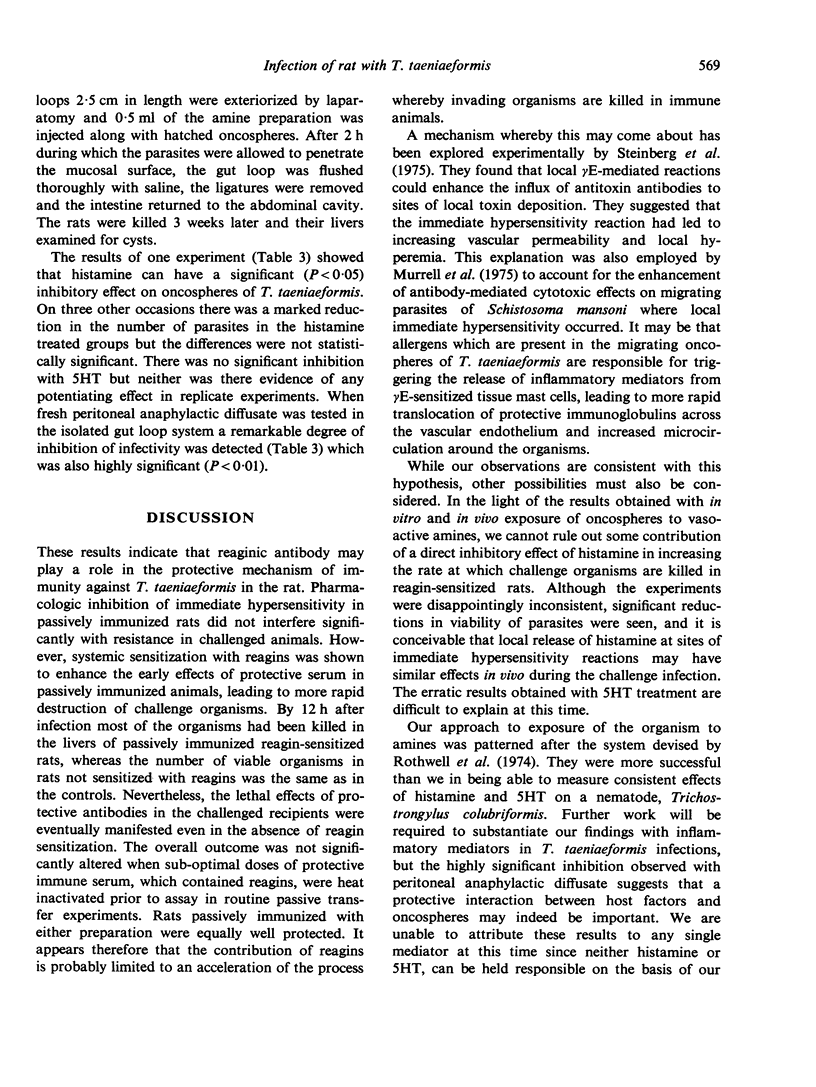Abstract
Chemical inhibitors of immediate hypersensitivity were used to treat rats passively immunized against Taenia taeniaeformis with serum containing 7Sγ2a and reaginic antibodies. There was no significant reduction in protection against oral challenge with eggs in these animals, indicating that reagin-mediated hypersensitivity reactions were not an essential component of the protective mechanism. However, systemic reagin sensitization was shown to result in an acceleration of the rate at which challenge organisms were destroyed in immune rats. By 12 h after infection most of the parasites had been killed in the livers of rats which had been both passively immunized and reagin-sensitized, whereas a large proportion survived in rats passively immunized, but not reagin-sensitized. This effect of reagin appeared to be limited to the early stages of resistance since parallel groups left for 21 days after challenge were shown to have been equally well protected.
In an effort to determine if vasoactive amines liberated by reagin-mediated reactions could act directly on invading parasites, early larval stages of T. taeniaeformis were exposed to histamine or serotonin (5HT) in vitro or in vivo. Consistent results were not obtained, but significant inhibition (P<0.05) of viability of parasites exposed to histamine occurred on two occasions. Significant (P<0.01) inhibition of infectivity of T. taeniaeformis also resulted when peritoneal anaphylactic diffusate was introduced into isolated gut loops containing hatched embryos of the parasite. The results are discussed in terms of the possible means whereby reagins may participate in protective immunity to infectious organisms.
Full text
PDF





Selected References
These references are in PubMed. This may not be the complete list of references from this article.
- Capron A., Dessaint J. P., Capron M., Bazin H. Specific IgE antibodies in immune adherence of normal macrophages to Schistosoma mansoni schistosomules. Nature. 1975 Feb 6;253(5491):474–475. doi: 10.1038/253474a0. [DOI] [PubMed] [Google Scholar]
- Keller R., Ogilvie B. M. The effects of drugs on worm expulsion in the Nippostrongylus brasiliensis infected rat: a discussion of the interpretation of drug action. Parasitology. 1972 Apr;64(2):217–227. doi: 10.1017/s0031182000029644. [DOI] [PubMed] [Google Scholar]
- Leid R. W., Williams J. F. Reaginic antibody response in rabbits infected with Taenia pisiformis. Int J Parasitol. 1975 Apr;5(2):203–208. doi: 10.1016/0020-7519(75)90030-2. [DOI] [PubMed] [Google Scholar]
- Leid R. W., Williams J. F. The immunological response of the rat to infection with Taenia taeniaeformis. I. Immunoglobulin classes involved in passive transfer of resistance. Immunology. 1974 Aug;27(2):195–208. [PMC free article] [PubMed] [Google Scholar]
- Leid R. W., Williams J. F. The immunological response of the rat to infection with Taenia taeniaeformis. II. Characterization of reaginic antibody and an allergen associated with the larval stage. Immunology. 1974 Aug;27(2):209–225. [PMC free article] [PubMed] [Google Scholar]
- Murrell K. D., Dean D. A., Stafford E. E. Resistance to infection with Schistosoma mansoni after immunization with worm extracts or live cercariae: role of cytotoxic antibody in mice and guinea pigs. Am J Trop Med Hyg. 1975 Nov;24(6 Pt 1):955–962. doi: 10.4269/ajtmh.1975.24.955. [DOI] [PubMed] [Google Scholar]
- Musoke A. J., Williams J. F., Leid R. W., Williams C. S. The immunological response of the rat to infection with taeniaeformis. IV. Immunoglobulins involved in passive transfer of resistance from mother to offspring. Immunology. 1975 Nov;29(5):845–853. [PMC free article] [PubMed] [Google Scholar]
- Stechschulte D. J., Austen K. F., Bloch K. J. Antibodies involved in antigen-induced release of slow reacting substance of anaphylaxis (SRS-A) in the guinea pig and rat. J Exp Med. 1967 Jan 1;125(1):127–147. doi: 10.1084/jem.125.1.127. [DOI] [PMC free article] [PubMed] [Google Scholar]


